When looking at my relationship with technology, I see a split in the middle of it being both healthy and unhealthy. There are three main “ways” or purposes of my technological uses: school, social media, and direct communication (being calling, emailing, or texting).
I think I give technology more than the appropriate amount of time in my life in all three of these usage components. When it comes to school, I miss using paper in classrooms. Writing notes and doing worksheets are much more beneficial for my retention of material and more helpful when studying. I don’t remember the last time when I was given worksheets to fill out, and typing notes takes a lot less focus than actually handwriting them. Always being on my laptop for class assignments is definitely more efficient, but it often gives me a headache and I don’t like looking at a screen for extended periods of time. I honestly don’t even want to get into my relationship with technology social media-wise – I know I’m on some platforms way too much and am aware of the negativity it brings me. My use of direct communication is the healthiest of all three. I love being able to text, call, Facetime, and email people, and how it’s only done when reciprocated. Since these require another person, it’s easy to have a balanced and appropriate amount of time spent utilizing these forms of communication.
The Fast Company article about the 14-year-old girl “unplugging” from social media emphasizes the permanency of digital use, even if it’s not yours. This article stuck out to me because it takes a commonality of social media and shares it from a differing perspective. There are so many parents and siblings who post content containing younger children that’s more than just a nice family photo or a cute sibling selfie. So many people can access your content, especially if it’s not private, and it’s dangerous and dumb to give your child a digital footprint before they can even do it for themselves. However, her family members violating her privacy and resulting in her deactivation of social media can be beneficial later on. Although there’s information of her out there, she’s very aware of social media consequences and her unplugging until she’s older will be something her future self will thank her for.































